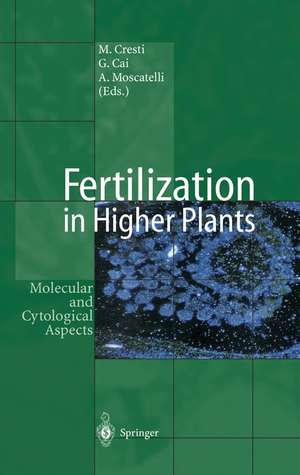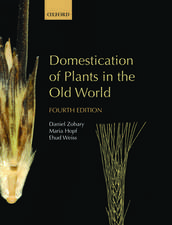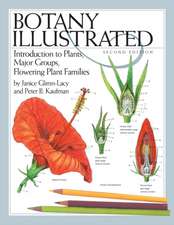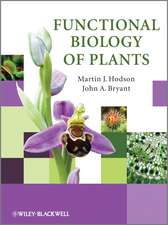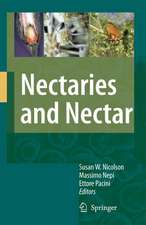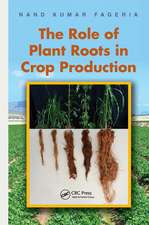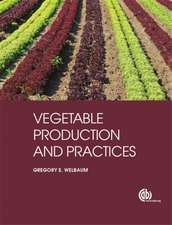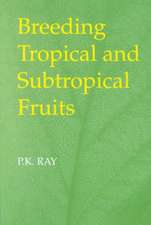Fertilization in Higher Plants: Molecular and Cytological Aspects
Editat de Mauro Cresti, Giampiero Cai, Alessandra Moscatellien Limba Engleză Paperback – 21 oct 2011
Fertilization in higher plants is a complex process consisting of two events, the fusion of the egg with one sperm cell resulting in the diploid zygote, and the fusion of embryosac nuclei with another sperm cell, leading to a triploid endosperm. This "double fertilization" is preceded by the pollination process and a long lasting interaction between the dipoid pistil and the haploid pollen tube (progamic phase). Fertilization of flowering plants results in the formation of seeds and fruits, our basic food supply.
Preț: 648.56 lei
Preț vechi: 763.01 lei
-15% Nou
Puncte Express: 973
Preț estimativ în valută:
124.13€ • 129.09$ • 103.87£
124.13€ • 129.09$ • 103.87£
Carte tipărită la comandă
Livrare economică 14-28 martie
Preluare comenzi: 021 569.72.76
Specificații
ISBN-13: 9783642642029
ISBN-10: 3642642020
Pagini: 464
Ilustrații: XIII, 447 p.
Dimensiuni: 155 x 235 x 24 mm
Greutate: 0.64 kg
Ediția:Softcover reprint of the original 1st ed. 1999
Editura: Springer Berlin, Heidelberg
Colecția Springer
Locul publicării:Berlin, Heidelberg, Germany
ISBN-10: 3642642020
Pagini: 464
Ilustrații: XIII, 447 p.
Dimensiuni: 155 x 235 x 24 mm
Greutate: 0.64 kg
Ediția:Softcover reprint of the original 1st ed. 1999
Editura: Springer Berlin, Heidelberg
Colecția Springer
Locul publicării:Berlin, Heidelberg, Germany
Public țintă
ResearchCuprins
1 Polyamines and Gene Expression of Biosynthetic Enzymes in Sexual Plant Reproduction.- 2 Carotenoid Biosynthesis in Plant Reproductive Organs: Regulation and Possible Functions.- 3 Lipid Accumulation and Related Gene Expression in Gametophytic and Sporophytic Anther Tissues.- 4 Sex Determination or Sex Dimorphism? On Facts and Terminology.- 5 Meiosis.- 6 Regulation of Gene Expression During Pollen Development.- 7 Double Fertilization in Flowering Plants: Origin, Mechanisms and New Information from in vitro Fertilization.- 8 Molecular Approach to Female Meiosis in Petunia Hybrida.- 9 Homomorphic Self-Incompatibility in Flowering Plants.- 10 Cell Death of Self-Incompatible Pollen Tubes: Necrosis or Apoptosis.- 11 Aspects of the Cell Biology of Pollination and Wide Hybridization.- 12 Pollen Coat Signals With Respect to Pistil Activation and Ovule Penetration in Gasteria Verrucosa (Mill.) H. Duval.- 13 Tapetum and Orbicules (Ubish Bodies): Development, Morphology and Role of Pollen Grainsand Tapetal Orbicules in Allergenicity.- 14 Development and Substructures of Pollen Grains Wall.- 15 Mechanisms of Microspore Polarity and Differential Cell Fate Determination in Developing Pollen.- 16 Genetic Control of Pollen Development and Function.- 17 The Use of the Vibrating Probe Technique to Study Steady Extracellular Currents During Pollen Germination and Tube Growth.- 18 The Role of Calcium and Associated Proteins in Tip Growth and Orientation.- 19 Measuring Ion Channel Activity During Polar Growth of Pollen Tubes.- 20 The Rheological Properties of the Pollen Tube Cell Wall.- 21 Actin Filament- and Microtubule-Based Motor Systems: Their Concerted Action During Pollen Tube Growth.- 22 The Pollen Tube Oscillator: Towards a Molecular Mechanism of Tip Growth.- 23 Fertilization and Zygotic Embryo Development in Vitro.- 24 MADS Box Genes Controlling Ovule and Seed Development in Petunia.- 25 Domains of Gene Expression in Developing Endosperm.- 26 Advances on the Study of Sexual Reproduction in the Corc-Tree (Quercus suber L), Chestnut (Castanea sativa Mill.) and in Rosaceae (Apple and Almond).- 27 Pollen as Food for Humans and Animals and as Medicine.- 28 Field Release of Transgenic Virus Tolerant Tomatoes.- 29 Grapevine Biotechnology Coming on the Scene.- Color Plates.
Textul de pe ultima copertă
Biotechnological methods are opening new ways in plant breeding. They allow novel strategies for improving crop productivity and quality, especially in the agrofood sector. The molecular mechanisms underlying these biotechnological approaches are presented here.
Topics included are: pollen development, pollen tube growth, macrosporogenesis and fertilization and the effects of pesticides on sexual plant reproduction.
Fertilization in higher plants is a complex process consisting of two events, the fusion of the egg with one sperm cell resulting in the diploid zygote, and the fusion of embryosac nuclei with another sperm cell, leading to a triploid endosperm. This "double fertilization" is preceded by the pollination process and a long lasting interaction between the dipoid pistil and the haploid pollen tube (progamic phase). Fertilization of flowering plants results in the formation of seeds and fruits, our basic food supply.
Topics included are: pollen development, pollen tube growth, macrosporogenesis and fertilization and the effects of pesticides on sexual plant reproduction.
Fertilization in higher plants is a complex process consisting of two events, the fusion of the egg with one sperm cell resulting in the diploid zygote, and the fusion of embryosac nuclei with another sperm cell, leading to a triploid endosperm. This "double fertilization" is preceded by the pollination process and a long lasting interaction between the dipoid pistil and the haploid pollen tube (progamic phase). Fertilization of flowering plants results in the formation of seeds and fruits, our basic food supply.
Caracteristici
The latest biotechnological applications in plant breeding are presented With several high quality color figures
